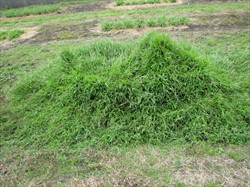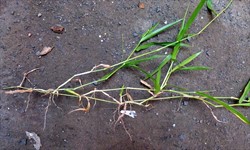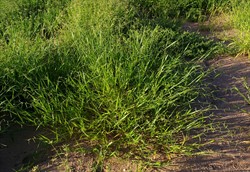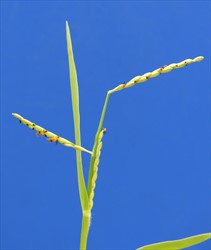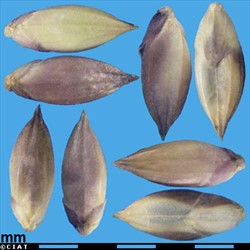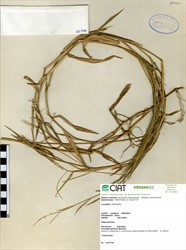Tropical Forages
Basionym: Panicum subquadriparum Trin.; Brachiaria subquadripara (Trin.) Hitchc.; Brachiaria miliiformis (C. Presl) Chase; Panicum miliiformis J. Presl
Family: Poaceae (alt. Gramineae) subfamily: Panicoideae tribe: Paniceae subtribe: Melinidinae.
Stoloniferous, mat-forming annual or short-lived perennial. Culms slender, straggling, rooting at lower nodes, 20–60 cm tall, nodes pubescent. Leaf sheaths loose, glabrous or with tubercle-based hairs or ciliate margins; leaf blades lanceolate or linear-lanceolate, 4–15 (–20) × 0.4–1 cm, glabrous or pubescent, base subrounded, margins thicker and scabrous, apex acute or acuminate. Inflorescence axis 3–10 cm; racemes 3–6, 2–4 (–6) cm, divergent to reflexed; rachis flat, 0.7–1 mm wide, narrowly winged, nearly glabrous; spikelets single, in 2 rows; pedicels glabrous. Spikelets elliptic to narowly obovate, (3–) 3.5–4 mm, glabrous, acute; lower glume broadly ovate, ⅓–½ spikelet length, 5–7-veined; upper glume separated from lower glume by a short internode, 5–7-veined; upper lemma finely rugose, apex subacute.
Similar species
U. subquadripara (Trin.) R.D. Webster: spikelets 3.2–4.3mm long; second lemma 2.6–2.8 mm long.
U. distachya (L.) T.Q. Nguyen: spikelets 2.4–3.0 mm long; second lemma 1.9–2.3 mm long.
Based on Veldkamp (1996).
U. subquadripara (Trin.) R.D. Webster: spikelets well-separated, 3–4 mm long; palea well-developed; lower glume ⅓–½ spikelet length.
U. piligera (F. Muell. ex Benth.) R.D. Webster (glabrous form): spikelets close-packed, 4–5 mm long; palea not significant; lower glume about ½ spikelet length.
Based on: http://ausgrass2.myspecies.info/content/urochloa-piligera
Asia: 四生臂形草 si sheng bi xing cao (China); niku-kibi (Japan)
English: Cori grass, armgrass millet, green summer grass, tropical signal grass
Pacific: thobuti (Fiji); mauspentotmafu (Rotuma); mohuku'apopoa (Tonga)
Other: nofh-lov-si (unknown)
Native:
Asia: Cambodia, China (Fujian, Guangdong, Guangxi, Guizhou, Hunan, Jiangxi, Yunnan), India (Assam, Bihar, Uttar Pradesh, West Bengal), Indonesia, Japan (Ryukyu Islands), Laos, Malaysia, Myanmar, Nepal, Philippines, Sri Lanka, Taiwan, Thailand, Vietnam
Australasia/Papuasia: Australia (New South Wales, Queensland, South Australia, Western Australia, Northern Territory), Papua New Guinea
Naturalized:
Northern America: Mexico, USA (s.e.)
Soil requirements
Grows well on sandy soils of medium to high fertility. In Australia, U. subquadripara is commonly found in well-structured, well-drained, red rainforest soils.
Moisture
High-rainfall (>1,750 mm/yr) recommended; particularly suited to monsoon environments. Well adapted to flooding conditions. Considered to be only moderately drought tolerant.
Temperature
Warm season grass.
Light
Good tolerance of shade.
Reproductive development
No information available.
Defoliation
Considered to withstand heavy grazing once well established.
Fire
No information available.
Guidelines for establishment and management of sown forages.
Establishment
Easily established from stolon cuttings buried 10–15 cm deep; minimum 1 plant/m².
Fertilizer
Considered to respond well to complete fertilizer mixtures and particularly to N.
Compatibility (with other species)
Once established, Cori grass competes well with weeds.
Companion species
Grasses: not normally sown with other grasses.
Legumes: Arachis pintoi, Centrosema molle, Grona heterophylla, Neustanthus phaseoloides.
Pests and diseases
No information available.
Ability to spread
Spreads by stolons.
Weed potential
Low because of insignificant seed production.
Nutritive value
6.25‒12.5% CP in 4‒8 wk-old regrowth.
Palatability/acceptability
Highly palatable.
Toxicity
Dry matter
Annual DM yields of 4‒17 t/ha have been reported, depending on N fertilization. Because of competition for nutrients and water, excessive grass productivity is considered detrimental for coconut production.
Animal production
At stocking rates of 1.5‒2.0 steers/ha up to 400 kg animal LWG/ha can be expected without affecting coconut yields.
2n = 54 and 72.
Reported to be very low.
Cori grass can be controlled with Diuron, Trifluralin and imazapyr.
- Shade tolerance.
- Palatability.
- Tolerance of flooding.
- Low to moderate productivity.
- Low seed production.
Reynolds, S.G. (1995) Pasture-Cattle-Coconut Systems. Food and Agriculture Organization of the United Nations (FAO), Bangkok, Thailand. fao.org/3/af298e/af298E00.htm
Schultze-Kraft, R. (1992) Brachiaria subquadripara (Trin.) Hitchc. In: Mannetje, L.’t and Jones, R.M. (eds) Plant Resources of South-East Asia No. 4. Forages. Pudoc Scientific Publishers, Wageningen, the Netherlands. p. 67–68. edepot.wur.nl/327785
Skerman, P.J. and Riveros, F. (1990) Tropical grasses. Food and Agriculture Organization of the United Nations (FAO), Rome, Italy. p. 260‒262. books.google.com/books?id=tCydcW6MK60C
Stanley, T.D. and Ross, E.M. (1989) Flora of South-eastern Queensland. Volume III. Queensland Department of Primary Industries, Brisbane. p. 218
Veldkamp, J.F. (1996) Brachiaria, Urochloa (Gramineae-Paniceae) in Malesia. Blumea 41:413–437. repository.naturalis.nl/document/565314
None released.
In the combined germplasm collections of CIAT, ILRI and the Australian Pastures Genebank, the species seems to be represented by only three accessions.
